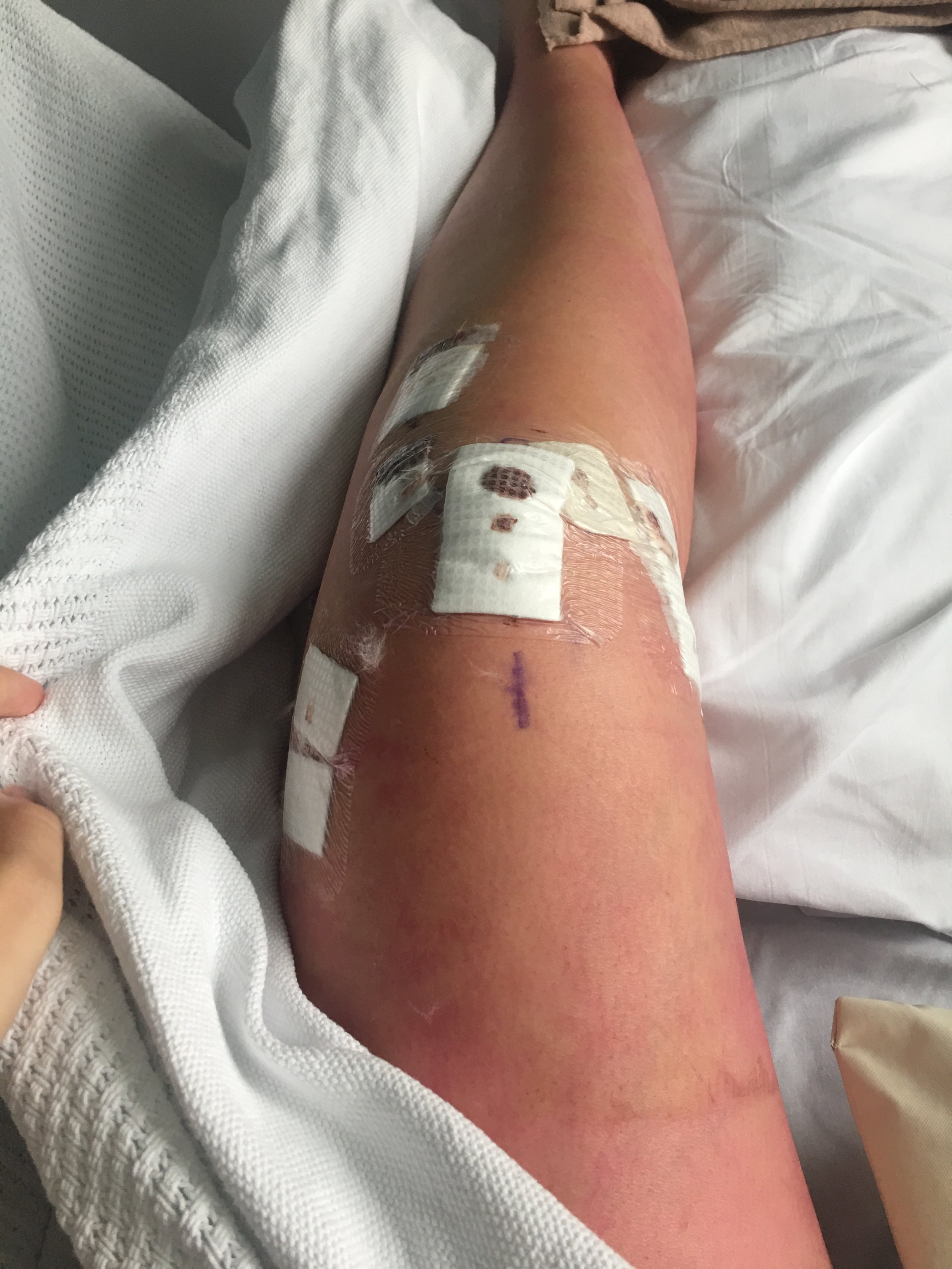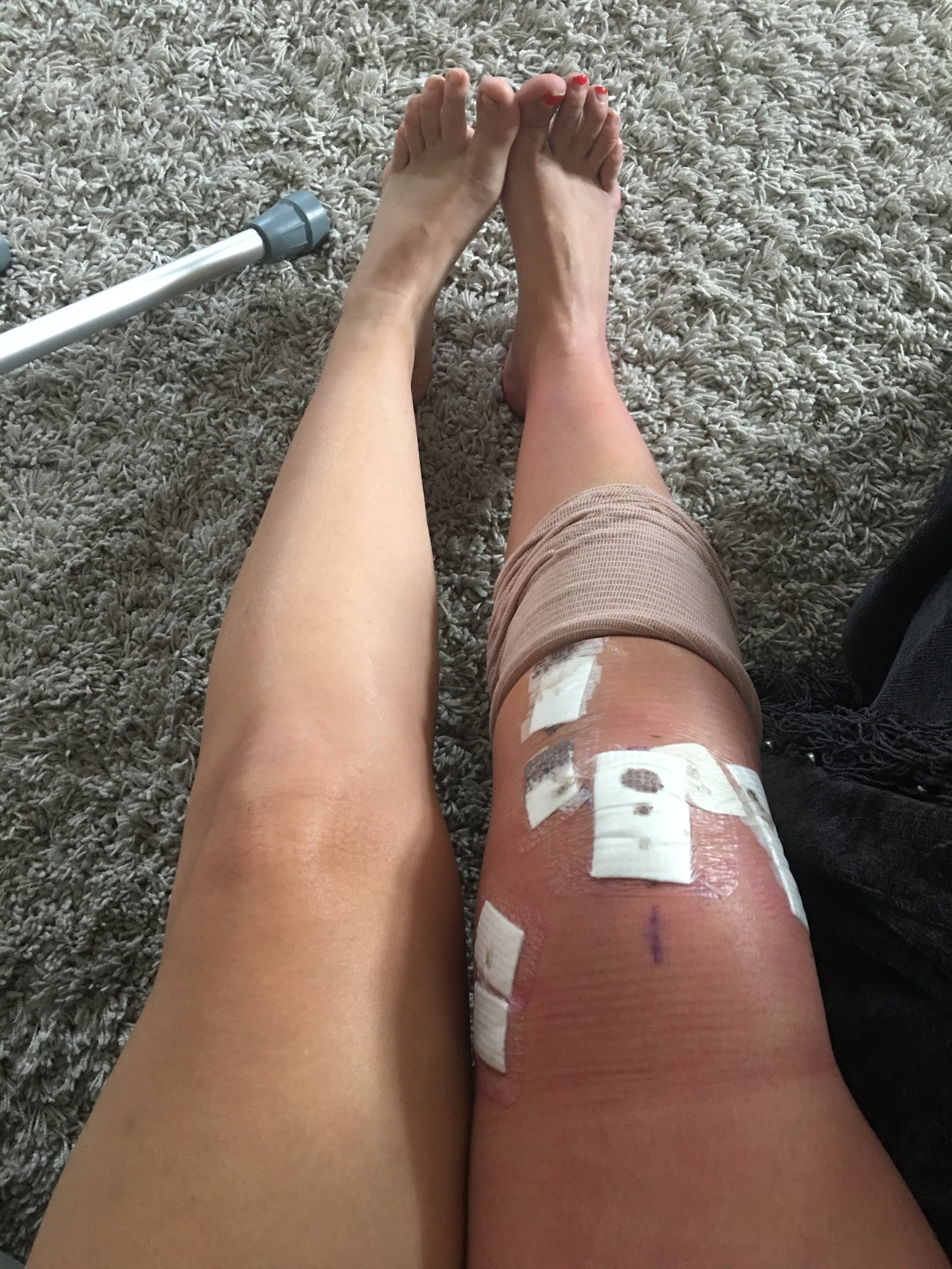How to prepare for knee surgery.
After eight knee surgeries, you’d think I’d know a thing or two about how to prepare. My latest ACL reconstruction was unexpected, and thrust me into (what felt like) unknown territory. I was afraid, unprepared and not ready for what faced me on the other side.
I’m now two weeks post op, and I’ve had a lot of time to reflect on the entire process and how my experience may help others. Getting your knee reconstructed has many physical constraints, but the mental often get forgotten and these are so important.
Below are the things that I wish someone had told me to prepare, and will make your surgery so much easier. Let me know in the comments if I’ve missed any! Also, if you’re reading this and preparing for your surgery… there is light at the end of the tunnel! (I’ve added in photos from my own surgery to show you progress as well).
Fresh out of surgery… still floating on the general anaesthetic high!
Clothing/Grippy Socks: The biggest thing people often forget is that you’ll be living in your pyjamas, or very loose clothing for a week or two. It’ll be painful to get anything tight up on your knee, so invest in some comfy long pants or shorts. Also, when you’re constantly applying ice to your knee, your feet can get cold… fast! Invest in a pair of grippy socks so you can wear them while you use your crutches around the house.
Canvas Bags: When you’re on crutches, you don’t have a spare hand to carry anything. Leave small canvas bags around the house, and make sure you’ve got one with you at all times so you can carry stuff around. You’ll be surprised at how handy these are - I carried my laptop and snacks around from the kitchen by using a canvas bag chucked on my arm. When I was out and about on crutches (out of the house), I used a backpack which was super easy to manage on crutches.
Out of hospital after two days!
Entertainment: After an ACL reconstruction, you’re going to be bored. Start writing a list now of shows you want to watch, podcasts you want to listen to and books you want to read. There is NEVER enough entertainment. You’ll also need entertainment from real human beings, and though it may feel like you want to sink into a hole of negativity, don’t! Schedule in visits with your family and friends, and catch up with them. It’s a great time to really have great conversations with pals, and to keep your spirits lifted.
Day 3 - first glimpse of the knee underneath the tubi-grip. Swollen, covered in betadine and sore.
Shower Essentials: Ahh, the dreaded bathroom. You’ll need to cover your leg when you shower, and the easiest way to do this is to buy plastic leg covers from your local chemist, or buy these from Amazon. You’ll need a small shower chair to sit down in the shower, and also make sure you’ve got a grippy bath mat that helps to support you once you’re out of the shower. Another thing I found helpful was having a separate (dry) chair in the bathroom to sit down on and get changed, and I also used this as a leg rest when I went to the toilet for the first few days, as my leg couldn’t bend properly.
Food/Drink: During this time, it’s hard to carry food and drink to your bed. In fact, it’s difficult to carry anything! If you’re living on your own, I’d suggest either food prepping before the surgery, or investing in pre-made meals like YouFoodz. It’s a difficult time losing your independence, but the ability to still feed yourself by grabbing a ready-to-go meal will keep your head high. Also, invest in a water bottle with a strap - something you can sling over your shoulder and carry around the house. The last thing you’ll be wanting to do is get up and constantly grab glasses of water!
Best friends visit - they helped to change my mood and lifted my spirits.
Prehab
If you’re lucky enough to be reading this a month or two before your surgery, make sure you prehab, prehab, prehab. Book in with your local physio, and strengthen up your legs like you’re preparing for a fitness show! The stronger your muscles are going into surgery, the faster and easier recovery will be after.
Bedding
Something that is easy to forget, but so important, is bedding. The first few nights you’ll probably need you leg propped with a pillow underneath, so have it all ready to go. I had my bed surrounded with pillows, extra blankets and a very comfortable mattress. Also, prepare your surroundings - have a bucket beside your bed in case of nausea, and a little basket that houses any physio notes, medication, notebook and pen and anything important that you need within reach. Keep your surroundings organised and accessible!
Day four was the hardest for me in terms of pain and swelling.
Ice-Machine or Loads of Iceblocks
Ice places a crucial role in early pain management and swelling, and you’ll need to be prepared with plenty of ice blocks to rotate with. I’ve never used an ice machine, but have been recommended it by plenty of people. The official name is a “Cold Therapy Machine”, and they continuously circulate cold water via an ice reservoir. You can read more about them HERE, and if they’re out of your price range, you can also consider hiring one.
Think Ahead
It’s easy to get caught up in the surgery, and forget what happens after. You’ll undoubtedly go home in a car, so practice that manoeuvre before it happens. You won’t be able to fully straighten or bend your leg, so make sure you’ll have room in the car. Will it suit you to sit in the front if the seat goes back far enough? Or perhaps sit in the middle in the back and have your foot resting on the glove box? Make sure the person who picks you up is also prepared, and can assist you getting in and out of the car.
Out and about on crutches. So important to get out of the house!
Mindset
When it comes to any surgery, the mental impact can have the biggest toll on your mindset. It’s incredibly important to have a positive mindset towards the surgery, and something that many of us struggle with. I found by setting myself small goals (like increasing range of movement, being able to lift the foot by itself, walking without crutches) made it seem like I was “winning”. Also, remember to be realistic. It’s highly unlikely you’ll be walking freely in the first few days, and that is okay. Let people take care of you, and be thankful for them. Try not to hold resentment towards those that are just trying to help, but rather try to see how helpful and loving they are being towards you!
Find a community
You might become frustrated trying to explain your surgery to friends and family, when it might be all that you want to talk about for a couple of weeks. I found joining support groups online really helped, especially the Facebook group, “ACL and knee support group”. I’ve posted in there a few times, and even asked for advice for this article. Find people that have been through similar journeys, and revel in the fact that they’re walking, running and are back to sport. It’ll get you motivated knowing that yep, if they can do it, you can do it as well!
Have you got any more suggestions for preparing for a knee surgery? I’d love to hear them in the comments below.





